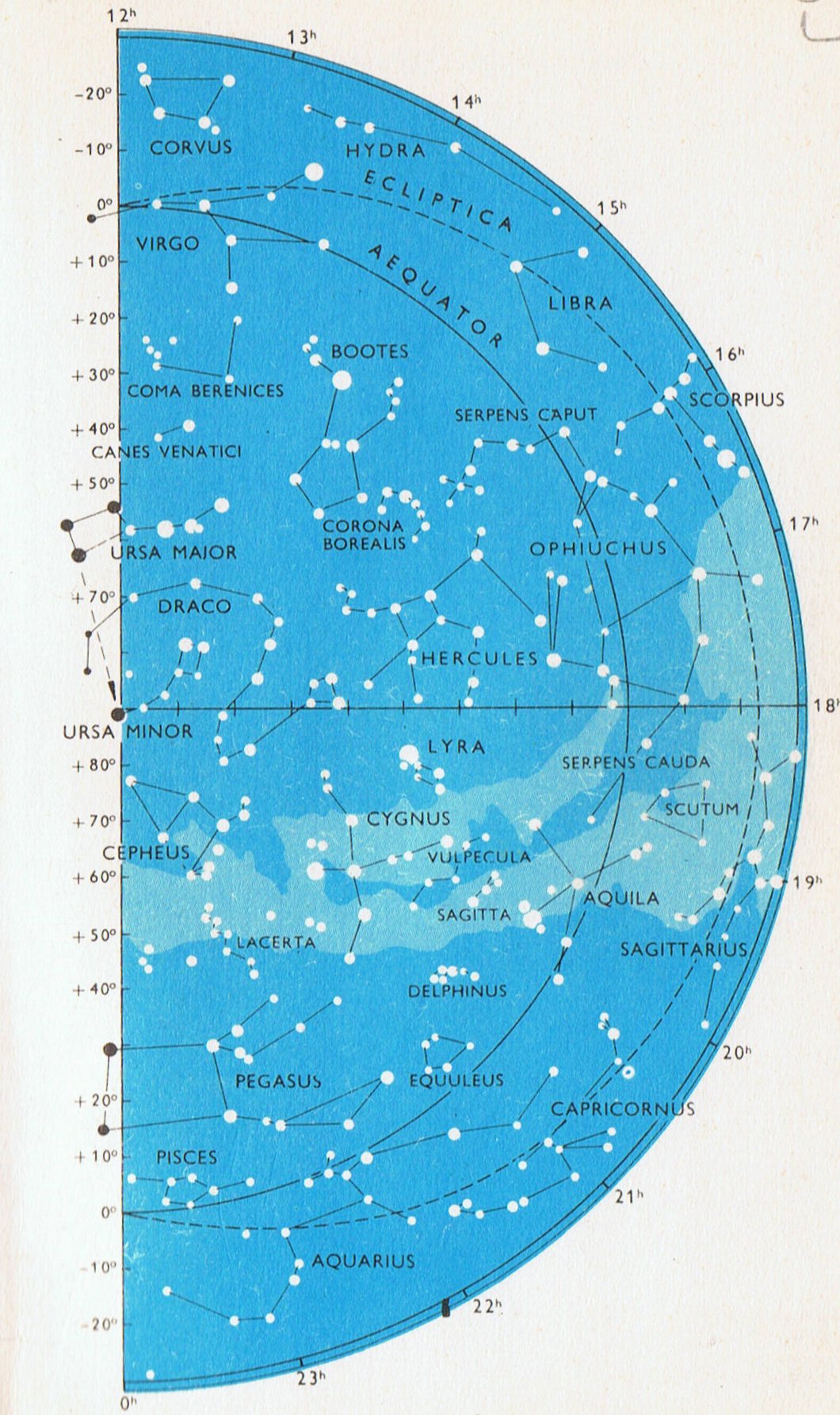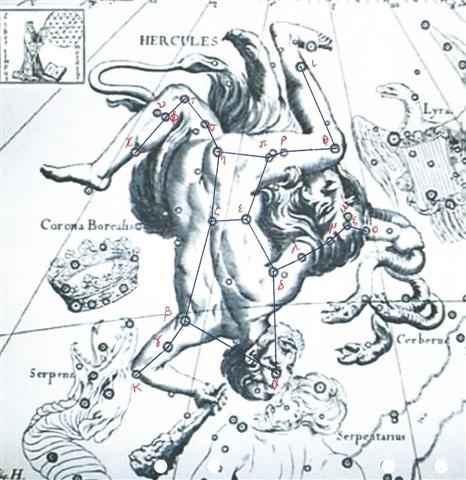On Hawaii they looked in the evenings for the Pleiades in autumn and in November 15 there were 3 stars (Alcyone, Pleione, and Atlas), which should be close to the Full Moon. Why 3 stars? Possibly because that was the distance from the First Point of Aries down to Hamal. There were 3 runes missing in the calendar. ... Then he thought of seeking them in the realm of Death, Tuonela, but in vain. He escaped back to the world of the living only thanks to his potent magic. He was still missing his three runes. He was then told by a shepherd to search in the mouth of Antero Vipunen, the giant ogre. The road, he was told, went over swords and sharpened axes. Ilmarinen made shoes, shirt and gloves of iron for him, but warned him that he would find the great Vipunen dead. Nevertheless, the hero went. The giant lay underground, and trees grew over his head. Vainamoinen found his way to the giant's mouth, and planted his iron staff in it. The giant awoke and suddenly opened his huge mouth. Vainamoinen slipped into it and was swallowed. As soon as he reached the enormous stomach, he thought of getting out. He built himself a raft and floated on it up and down inside the giant. The giant felt tickled and told him in many and no uncertain words where he might go, but he did not yield any runes. Then Vainamoinen built a smithy and began to hammer his iron on an anvil, torturing the entrails of Vipunen, who howled out magic songs to curse him away. But Vainamoinen said, thank you, he was very comfortable and would not go unless he got the secret words. Then Vipunen at last unlocked the treasure of his powerful runes. Many days and nights he sang, and the sun and the moon and the waves of the sea and the waterfalls stood still to hear him. Vainamoinen treasured them all and finally agreed to come out. Vipunen opened his great jaws, and the hero issued forth to go and build his boat at last ...
Ideally, they had said, there should be 33 days from the first sighting of the Pleiades in the evening to the solstice. 355 (December 21) - 33 = 322 (November 18). Or rather November 19 = 32 days to the solstice because precession could have moved the Pleiades ahead with about a day from the time of Captain Cook. ... In the latter eighteenth century, the Pleiades appear at sunset on 18 November. Ten days later (28 November), the Lono effigy sets off on its circuit, which lasts twenty-three days, thus bringing the god back for the climactic battle with the king on 21 December, the solstice (= Hawaiian 16 Makali'i). The correspondence is 'ideal' and only rarely achieved, since it depends on the coincidence of the full moon and the crepuscular rising of the Pleiades ... At the time of rongorongo the optimal coincidence with the Full Moon would thus appear to give November 19 + 10 = November 29 as the date for when the Lono (Rogo) effigy would begin its circuit, with day 333 (= 323 + 10) + 23 = 356 (December 22) as its return. However, the precession could perhaps here be ignored because the solstice had to be at December 21 and we are searching for ideal dates. ... In the deep night before the image [of Lono] is first seen, there is a Makahiki ceremony called 'splashing-water' (hi'uwai). Kepelino tells of sacred chiefs being carried to the water where the people in their finery are bathing; in the excitement created by the beauty of their attire, 'one person was attracted to another, and the result', says this convert to Catholicism, 'was by no means good'. At dawn, when the people emerged from their amorous sport, there standing on the beach was the image of Lono. White tapa cloth and skins of the ka'upu bird hang from the horizontal bar of the tall crosspiece image. The ka'upu is almost certainly the albatross, a migratory bird that appears in the western Hawaiian chain - the white Lanyon albatross at Ni'ihau Island - to breed and lay eggs in October-November, or the beginning of the Makahiki season ...
The occurrence of a pair of niu (baby palm trees) could suggest both 32 and 33 days were in the mind of the creator of the text. November 18 was day 322 and this was twice as much as June 10 (161) when the Oak-king (Jupiter) month began, when he should be sacrificed in fire. Hi'uwai (Water Tail) could be a complementary occasion in December, when the fire of the old year should be extinguished. ... Uruga. Prophetic vision. It is said that, not long before the first missionaries' coming a certain Rega Varevare a Te Niu saw their arrival in a vision and travelled all over the island to tell it: He-oho-mai ko Rega Varevare a Te Niu mai Poike, he mimiro i te po ka-varirˇ te kaiga he-kţ i taana uruga, he ragi: 'E-tomo te haűti i Tarakiu, e-tomo te poepoe hiku regorego, e-tomo te ţka ariga koreva, e-tomo te poporo haha, e-kiu te Atua i te ragi'. I te otea o te rua raß he-tu'u-hakaou ki Poike; i te ahi mo-kirokiro he-mate. Rega Varevare, son of Te Niu, came from Poike, and toured the island proclaiming his vision: 'A wooden house will arrive at Tarakiu (near Vaih˙), a barge will arrive, animals will arrive with the faces of eels (i.e. horses), golden thistles will come, and the Lord will be heard in heaven'. The next morning he arrived back in Poike, and in the evening when it was getting dark, he died ... Ignoring the precession from the time of Gregory XIII means we could assume the bird with empty eye holes in Cb2-13 should correspond to day 322. Here Metoro said ihe manu ra, which seems to mean a cardinal point (ihe) for the dead old Sun bird (manu ra). A new cycle should begin when the Full Moon reached the 3 stars of the Foundation Stone. But this was about a month before the solstice and therefore the new cycle was as yet only 'sleeping' (moe).
It was 'sleeping' in that part of the Milky Way (Te Goe) which was like a Shark (Mago):
... Fetu-tea [Pale Star = Saturn] was the king. He took to wife the dome of the sky, Te-Tapoi-o-te-ra'i, and begat stars that shine (hitihiti) and obscure, the host of twinkling stars, fetu-amoamo, and the phosphorescent stars, te fetu-pura-noa. There followed the star-fishes, Maa-atai, and two trigger-fishes that eat mist and dwell in vacant spots in the Milky Way, the Vai-ora or Living-water of Tane. The handsome shark Fa'a-rava-i-te-ra'i, Sky-shade, is there in his pool and close by is Pirae-tea, White Sea-swallow (Deneb in Cygnus) in the Living-waters of Tane ... ... This Snake-river of sparkling dust, the stream of the abyss on high through which it runs, the golden cord of the heaven-god ... connected alike with the hill of the Sun-god and with the passage of ghosts, is the Milky Way ... The Norsmen knew it as the Path of the Ghosts going to Valh÷ll (Valhalla), in the region Gladsheimr, - the palace of their heroes slain in battle; and our North American Indians had the same idea, as witness the 'wrinkled old Nokomis', when, teaching the little Hiawatha, she Showed the broad white road in heaven, / Pathway of the ghosts, the shadows, / Running straight across the heavens, / Crowded with the ghosts, the shadows, / To the Kingdom of Ponemah, / To the land of the hereafter; the brighter stars along the Road marking their camp-fires ... Our aborigines and the Eskimo also called it the Ashen Path, as did the Bushmen of Africa, - the ashes hot and glowing, instead of cold and dark ...
Notably ihe manu ra coincided with where the Sun reached Hyadum I - i.e. a place corresponding to the end of side b on the G tablet. And close to the Full Moon could be observed the complementary place where the upside down Hercules had bent his right knee:
|
|||||||||||||||||||||||||||||||||||||||||||||||||||||||||||||||||||||||||||||||||||||||||||||||||||||||||||||||||||||||||











